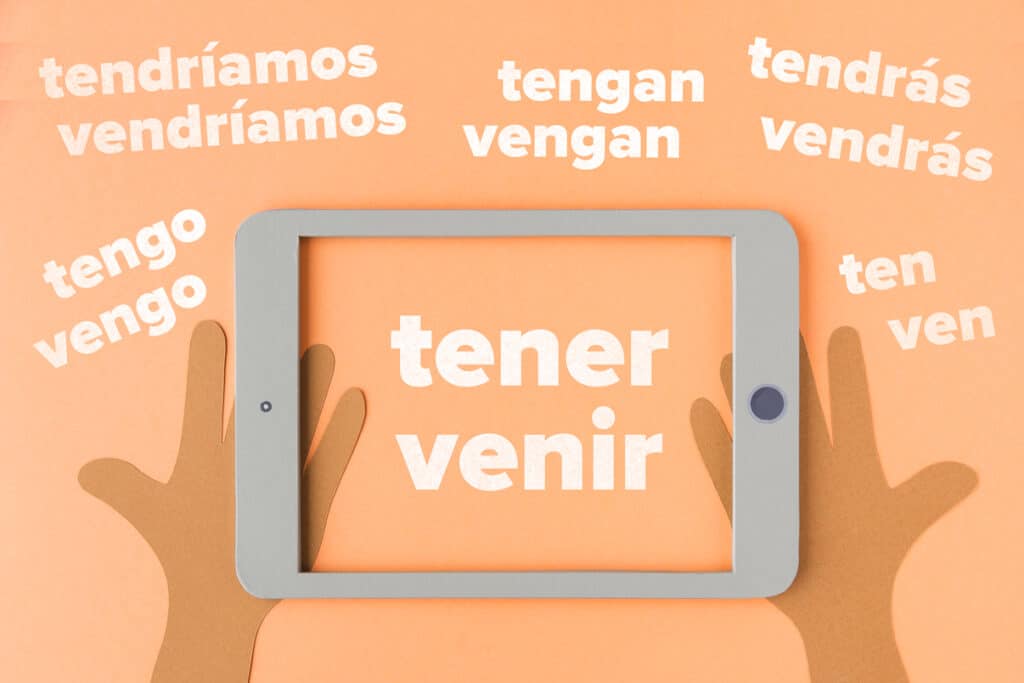
Learning Spanish can have many surprises and challenges.
Why are there so many verb conjugations? Why are some of the most commonly-used verbs some of the most difficult ones to conjugate!?
An effective shortcut for learning tricky verb conjugations is to group verbs with similar conjugations and learn them together.
That’s what this article does with the two of the most important but irregular Spanish verbs: Tener
(to have) and venir
(to come).
Read on to learn exactly how and when to use tener and venir!
Contents
Download:
This blog post is available as a convenient and portable PDF that you
can take anywhere.
Click here to get a copy. (Download)
Why Are Tener and Venir so Important?
The verbs tener and venir are two of the most common words you’ll see or hear when reading or listening to Spanish. (In fact, they’re both among the 100 most common Spanish verbs, according to SpanishDictionary.com.) But just because these verbs are frequently used doesn’t mean they’re easy to use.
In English, some of our most common verbs are irregular. Think about verbs like “have,” “be,” “do,” “go” and “say.” The same is true of Spanish: You’ll find that many essential Spanish verbs, like tener and venir, have confusing conjugations.
What’s more, tener and venir have a variety of different meanings. They’re also used in a number of colloquial expressions and phrases.
Therefore, mastering these two verbs’ various meanings and usages is key to improving your Spanish ability.
But never fear: This article will include information on conjugation, meaning, usage and common expressions.
How to Use Tener and Venir
Mastering tener
The verb tener means “to have”:
Me gustaría tener un perro.
(I would like to have a dog.)
Beyond meaning “to have,” tener is commonly used in Spanish to describe states of being. This is a type of construction that doesn’t exist in English, but it shows up frequently in Spanish.
One example is the phrase tener hambre
. This phrase directly translates to “to have hunger.” Therefore, you might be able to guess that tener hambre actually means “to be hungry.”
Here are some other common phrases in Spanish that work like this:
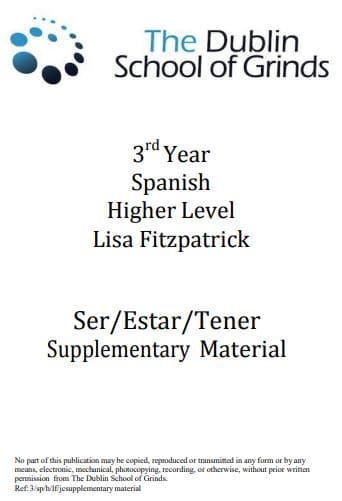
These uses of tener are very important in Spanish. If you’d like to learn more or get some practice distinguishing tener from ser and estar when describing states of being, there are many great worksheets online.
See, for example, page three of The Dublin School of Grinds’ Spanish textbook.
All about venir
The verb venir means “to come”:
¿Quieres venir a mi casa a cenar?
(Do you want to come to my house to have dinner?)
It’s important to distinguish between venir (to come) and its close relative, ir
(to go).
While both of these verbs imply movement, their usage depends on where the speaker is when they use the verb, as well as the place that they’re talking about.
Use venir to describe movement towards the place where you are. Use ir to talk about movement away from the place where you are.
Some examples will help this make sense. Let’s say I’m sitting on my couch and I call a friend on the phone. I might say:
¿Vas a venir a mi casa esta tarde?
(Are you going to come to my house this afternoon?)
I use venir because I’m describing someone moving towards the place where I currently am.
On the other hand, if my friend and I are planning on going out, I might say:
¿Quieres ir al cine esta tarde?
(Do you want to go to the movies this afternoon?)
Since I’m describing movement away from where I am, I use ir.
Really, the distinction between venir and ir is no different than the distinction between the English words “come” and “go.” However, this distinction is second-nature to us as native English speakers, whereas its Spanish equivalent might take some more time to get used to.
If you’re having trouble keeping the two verbs straight, I recommend listening to Ricky Martin’s “Vente pa’ ca” (“Come Over Here”) until you remember the meaning of venir. You can follow along with the lyrics on Genius.
Conjugating Tener and Venir
There’s a reason why people commonly study tener and venir alongside one another: These two verbs are both irregular, but they often follow a similar conjugation pattern. As you study the conjugation guide below, look for these patterns to make them easier to remember.
Below, you can find the conjugation patterns for these two verbs in the tenses where they’re irregular. I haven’t included some of the other conjugations (for example, the imperfect tense and the past subjunctive) because in these tenses, tener and venir follow normal conjugation patterns.
Tener conjugations
Present tense:
| Spanish | English |
|---|---|
| yo tengo |
I have |
| tú tienes |
you have (singular, informal) |
| él/ella, usted tiene |
he/she has, you have (singular, formal) |
| nosotros tenemos |
we have |
| vosotros tenéis |
you have (plural, informal) |
| ellos/ellas, ustedes tienen |
they have, you have (plural, formal) |
Past tense:
| Spanish | English |
|---|---|
| yo tuve |
I had |
| tú tuviste |
you had (singular, informal) |
| él/ella, usted tuvo |
he/she had, you had (singular, formal) |
| nosotros tuvimos |
we had |
| vosotros tuvisteis |
you had (plural, informal) |
| ellos/ellas, ustedes tuvieron |
they had, you had (plural, formal) |
Future tense:
| Spanish | English |
|---|---|
| yo tendré |
I will have |
| tú tendrás |
you will have (singular, informal) |
| él/ella, usted tendrá |
he/she will have, you will have (singular, formal) |
| nosotros tendremos |
we will have |
| vosotros tendréis |
you will have (plural, informal) |
| ellos/ellas, ustedes tendrán |
they will have, you will have (plural, formal) |
Conditional tense:
| Spanish | English |
|---|---|
| yo tendría |
I would have |
| tú tendrías |
you would have (singular, informal) |
| él/ella, usted tendría |
he/she would have, you would have (singular, formal) |
| nosotros tendríamos |
we would have |
| vosotros tendríais |
you would have (plural, informal) |
| ellos/ellas, ustedes tendrían |
they would have, you would have (plural, formal) |
Present subjunctive:
| Spanish | English |
|---|---|
| yo tenga |
I have |
| tú tengas |
you have (singular, informal) |
| él/ella, usted tenga |
he/she has, you have (singular, formal) |
| nosotros tengamos |
we have |
| vosotros tengáis |
you have (plural, informal) |
| ellos/ellas, ustedes tengan |
they have, you have (plural, formal) |
Imperative:
| Spanish | English |
|---|---|
| tú ten |
you have/have! (singular, informal) |
| usted tenga |
you have/have! (singular, formal) |
| nosotros tengamos |
we have/let’s have! |
| vosotros tened |
you have/have! (plural, informal) |
| ustedes tengan |
you have/have! (plural, formal) |
Venir conjugations
Present tense:
| Spanish | English |
|---|---|
| yo vengo |
I come |
| tú vienes |
you come (singular, informal) |
| él/ella, usted viene |
he/she comes, you come (singular, formal) |
| nosotros venimos |
we come |
| vosotros venís |
you come (plural, informal) |
| ellos/ellas, ustedes vienen |
they come, you come (plural, formal) |
Past tense:
| Spanish | English |
|---|---|
| yo vine |
I came |
| tú viniste |
you came (singular, informal) |
| él/ella, usted vino |
he/she came, you came (singular, formal) |
| nosotros vinimos |
we came |
| vosotros vinisteis |
you came (plural, informal) |
| ellos/ellas, ustedes vinieron |
they came, you came (plural, formal) |
Future tense:
| Spanish | English |
|---|---|
| yo vendré |
I will come |
| tú vendrás |
you will come (singular, informal) |
| él/ella, usted vendrá |
he/she will come, you will come (singular, formal) |
| nosotros vendremos |
we will come |
| vosotros vendréis |
you will come (plural, informal) |
| ellos/ellas, ustedes vendrán |
they will come, you will come (plural, formal) |
Conditional tense:
| Spanish | English |
|---|---|
| yo vendría |
I would come |
| tú vendrías |
you would come (singular, informal) |
| él/ella, usted vendría |
he/she would come, you would come (singular, formal) |
| nosotros vendríamos |
we would come |
| vosotros vendríais |
you would come (plural, informal) |
| ellos/ellas, ustedes vendrían |
they would come, you would come (plural, formal) |
Present subjunctive:
| Spanish | English |
|---|---|
| yo venga |
I come |
| tú vengas |
you come (singular, informal) |
| él/ella, usted venga |
he/she comes, you come (singular, formal) |
| nosotros vengamos |
we come |
| vosotros vengáis |
you come (plural, informal) |
| ellos/ellas, ustedes vengan |
they come, you come (plural, formal) |
Imperative:
| Spanish | English |
|---|---|
| tú ven |
you come/come! (singular, informal) |
| usted venga |
you come/come! (singular, formal) |
| nosotros vengamos |
we come/let’s (all) come! |
| vosotros venid |
you come/come! (plural, informal) |
| ustedes vengan |
you come/come! (plural, formal) |
These, again, aren’t all the conjugations—just the irregular ones. For all conjugations of tener and venir in one convenient place, check out Conjugation.org.
Practicing tener and venir conjugations
The conjugations of tener and venir are complicated.
But that doesn’t mean that you should throw up your hands in frustration! There are tons of online resources to help you out.
There’s a great Quizlet flashcard set on the present tense conjugations of these verbs. You can first set the cards to Spanish and try to translate them into English. Then, when you feel more confident, switch the cards to English and try to remember each Spanish conjugation.
You can also practice conjugating tener and venir using this quiz available on StudySpanish.com or this wordsearch conjugation game on Conjuguemos.
Colloquial Expressions with Tener and Venir
Tener and venir are also useful verbs because they show up in a number of Spanish colloquial expressions. (In fact, you can find a whole article just about tener expressions!)
Here are some of the most common expressions with tener and venir:
Tener en mente
(To keep in mind)
Es importante tener en mente que no todo el mundo tiene las mismas creencias.
(It’s important to keep in mind that not everybody has the same beliefs.)
Tener ganas de
(To want/desire)
Ya son las cinco de la tarde y tengo muchas ganas de salir del trabajo.
(It’s already 5:00 p.m., and I really want to leave work.)
Tener que ver con
(To have to do with)
Sí, eso es interesante, pero ¿qué tiene que ver con nuestra conversación?
(Yes, that’s interesting, but what does it have to do with our conversation?)
Tener razón
(To be right)
No le hice caso, pero resulta que tenía razón.
(I didn’t listen to her, but it turns out she was right.)
Tener que
(To have to)
Quiero salir con mis amigos, pero primero tengo que limpiar la casa.
(I want to go out with my friends, but first I have to clean the house.)
Tener claro
(To understand, to see, to be sure)
Ahora tengo claro que ella no es una buena amiga.
(Now I see that she’s not a good friend.)
Tener cuidado
(To be careful)
Esquiar es muy divertido, pero hay que tener cuidado.
(Skiing is really fun, but you have to be careful.)
It’s also very common to see this phrase in its command form:
¡Ten cuidado!
(Be careful!)
Venir bien
/ Venir mal
(To be convenient/inconvenient, to seem good/bad)
No me viene bien que vengas este fin de semana porque tengo muchas cosas que hacer.
(It’s not convenient for me for you to come this weekend because I have a lot of things to do.)
A las 8 me viene mal, ¿podemos salir a las 9?
(8:00 is inconvenient for me, can we leave at 9:00?)
Estar por venir
(To be about to happen)
Ya nos hemos divertido mucho, ¡pero lo mejor está por venir!
(We’ve had a lot of fun already, but the best is yet to come!)
Venir de
(To come from)
This is one of the most common phrases for beginning Spanish speakers, because it’s a great way to introduce yourself. It’s a synonym for ser de
(to be from).
Vengo de Colombia.
(I come from Colombia.)
Venir al pelo
(To be perfect)
El vestido me viene al pelo, voy a comprarlo sin dudas.
(The dress is perfect for me, I’m going to buy it without a doubt.)
Venir a cuento
(To be relevant, to be appropriate)
Las ideas de Foucault son importantes, pero no vienen a cuento en este caso.
(Foucault’s ideas are important, but they are not appropriate in this case.)
Learning colloquialisms can be one of the most fun parts of language learning, because it allows you to move beyond the classroom and converse the way native speakers do. Beyond that, it’s important to learn common expressions like these because native Spanish speakers use them all the time. You can get a sense of how these verbs and expressions are used naturally by studying with an immersive language learning program like FluentU.
Tener and venir aren’t the easiest Spanish verbs to learn. But as this article shows, they’re definitely worth learning—and you can learn all their irregular conjugations!
All you have to do is tener fe
(have faith) and tener confianza
(be confident)!
Download:
This blog post is available as a convenient and portable PDF that you
can take anywhere.
Click here to get a copy. (Download)
And One More Thing…
If you’ve made it this far that means you probably enjoy learning Spanish with engaging material and will then love FluentU.
Other sites use scripted content. FluentU uses a natural approach that helps you ease into the Spanish language and culture over time. You’ll learn Spanish as it’s actually spoken by real people.
FluentU has a wide variety of videos, as you can see here:

FluentU brings native videos within reach with interactive transcripts. You can tap on any word to look it up instantly. Every definition has examples that have been written to help you understand how the word is used. If you see an interesting word you don’t know, you can add it to a vocab list.
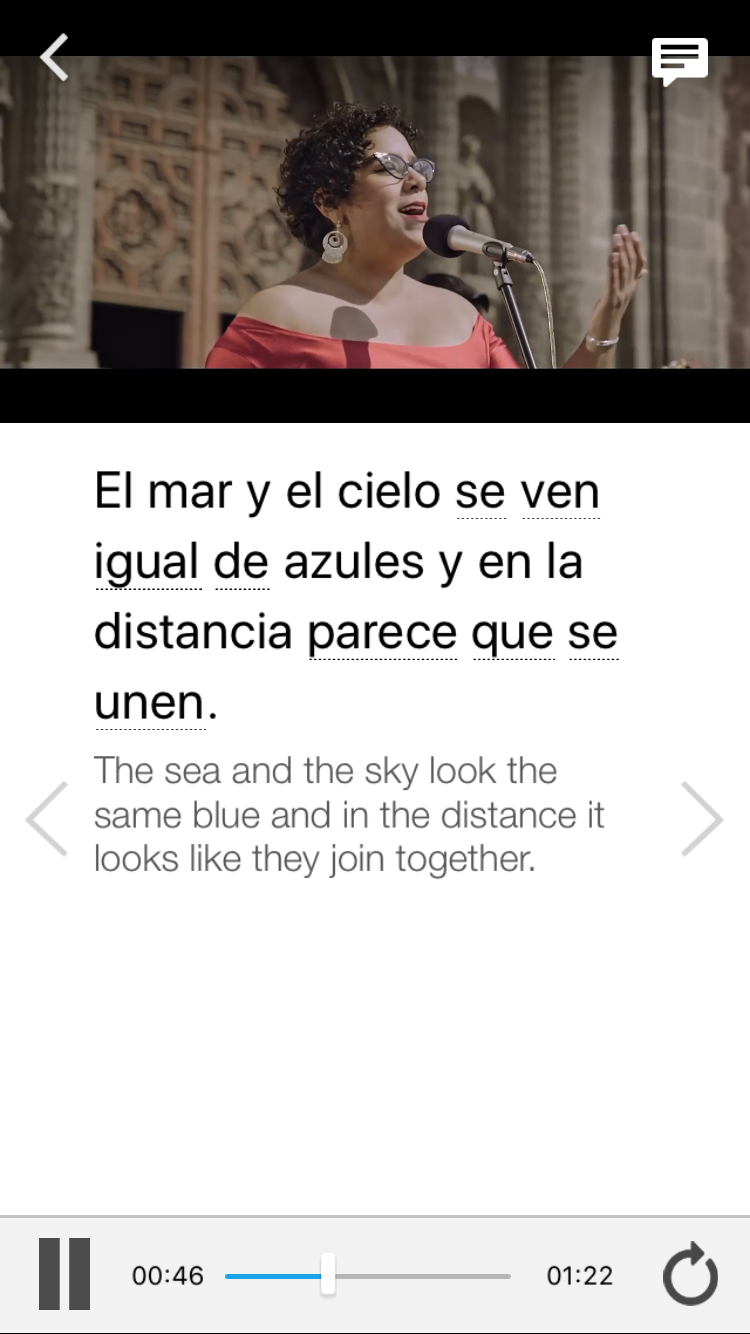
Review a complete interactive transcript under the Dialogue tab, and find words and phrases listed under Vocab.
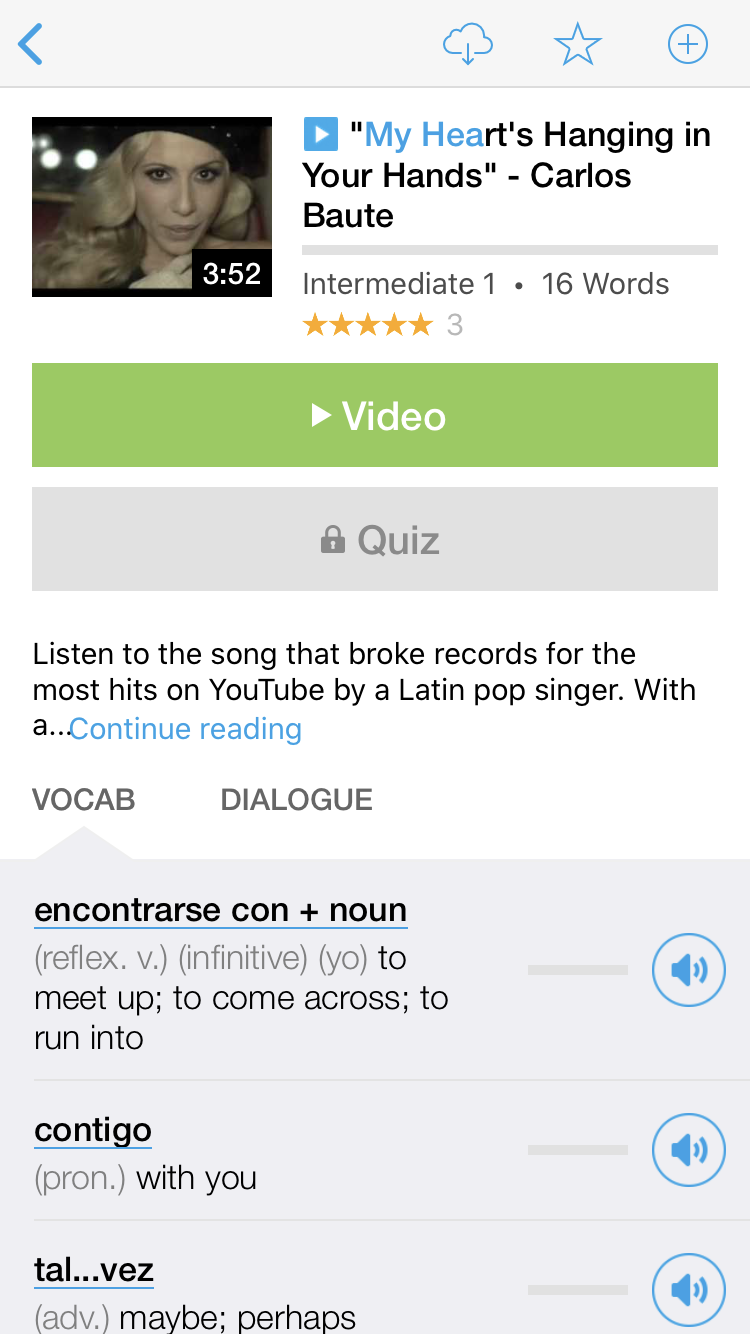
Learn all the vocabulary in any video with FluentU’s robust learning engine. Swipe left or right to see more examples of the word you’re on.
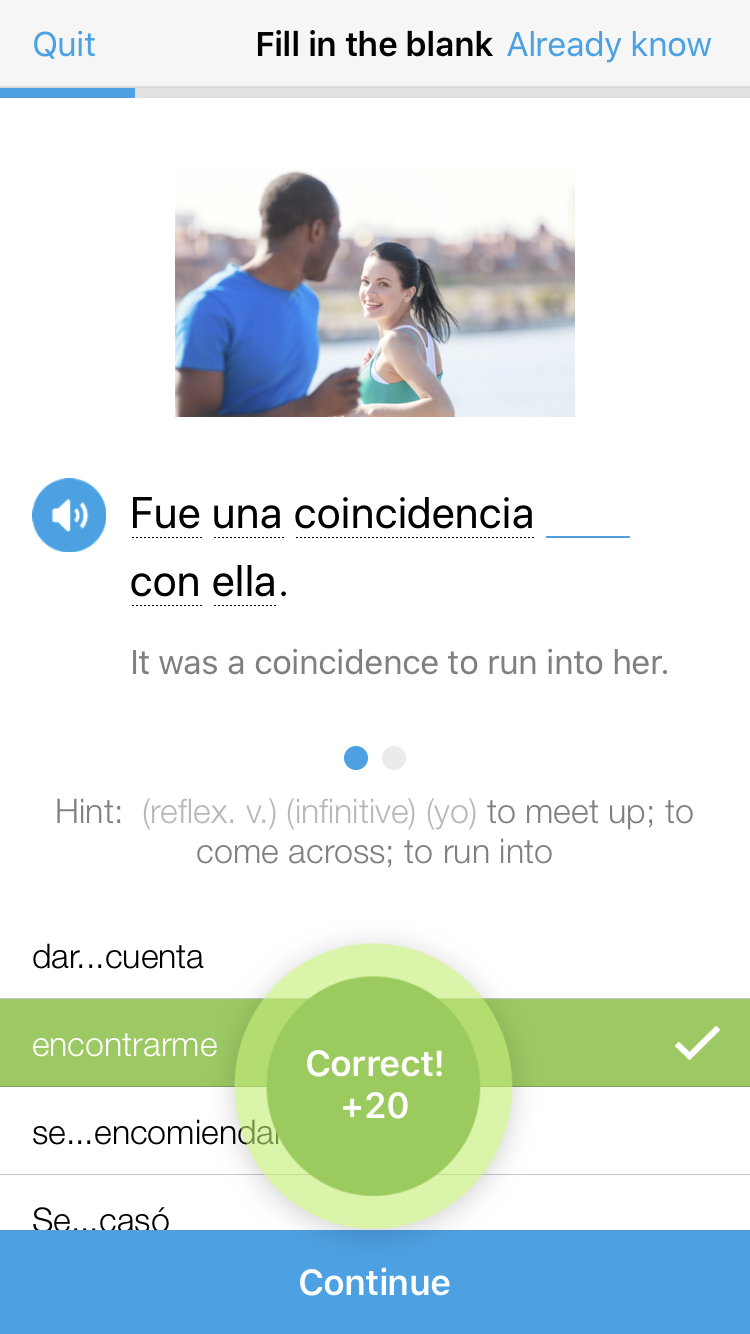
The best part is that FluentU keeps track of the vocabulary that you’re learning, and gives you extra practice with difficult words. It’ll even remind you when it’s time to review what you’ve learned. Every learner has a truly personalized experience, even if they’re learning with the same video.
Start using the FluentU website on your computer or tablet or, better yet, download the FluentU app from the iTunes or Google Play store. Sign up by November 28th to receive a 60% discount with our Black Friday sale!



